
In a candid interview at SaaStr Annual 2015, Parker Conrad, CEO of Zenefits, and VP of Sales Sam Blond share their journey that started with a simple “What if…?” and how that led to an audacious goal: deciding mid-year to double their sales plan from $10M to $20M. They reveal the growth challenges of hyperscaling from 1 to 100 reps in less than a year, the infrastructure and hiring strategies needed to support it, and the key to a successful CEO/VP Sales relationship.
And if you think this video is great, it’s just one of a full day of sessions from the SaaStr Annual 2015 available here. And be sure to register for the SaaStr Annual 2016, where we’ll have three days of incredible CEO interviews and deep dive workshops with the best in the business. You don’t want to miss it.
Check out the full transcript below!
TRANSCRIPT
Parker Conrad: You make an impression.
Jason Lemkin: Thank you for coming.
Parker: Good to see you.
Jason: Looking good. I like the look. Good to see you. I need a pocket, there’s the problem.
This is a treat. You can hear a lot of CEOs drone on and on. I’ve done it before. You can see VPs of sales, but getting a super successful team together between these two sessions, I haven’t seen it before.
Thanks for coming. This is it. We’re all lucky.
Parker: Thank you. We’re happy to be here.
Jason: Lots of stuff we’d love to chat about. Zenefits had a good 2014, as I understand, is that right? Some good growth.
Parker: So far so good.
Aaron Ross: Not too shabby.
Jason: Parker, you want to give us 30 seconds on the company and 30 seconds on 2014?
Parker: Basically, what we do is, we solve this problem that I think, pretty much every business in the 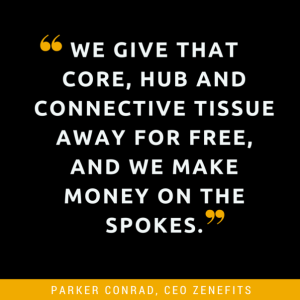 United States with less than a thousand employees has. Which is that you have 20 different systems related to HR.
United States with less than a thousand employees has. Which is that you have 20 different systems related to HR.
Because of that, any time you hire or terminate someone, you need to set them up or remove them from 20 different places.
If the world made any sense, all the stuff would be connected up. There would be a single place that companies and their employees go to make changes. It would propagate everywhere else.
That’s essentially what Zenefits is, with the wrinkle that we give that core, hub and connective tissue away for free, and we make money on the spokes in this hub and spoke system.
Jason: Last year we grew about 20x, something like that, right? You did put the numbers in TechCrunch or somewhere like that. 1 to 20 million or something like that in run rate, right?
As amazing as that sounds, I think you and I probably met five or six months before that, when you reminded me, I think you were doing about 15K in MRR, so a lot of growth.
A lot of things we can chat about, but let’s go back in time. We met, and I connected you with Sam. Sam, how many folks did you hire last year?
Sam Blond: Today, we’re at about 95 sales reps.
Jason: You added about 94 of those sales reps to the team? 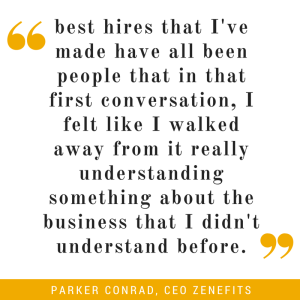
Sam: Yes, exactly [laughs] .
Jason: Quite a bunch of scaling.
Parker: The one that I hired was really good.
Jason: What’s that?
Parker: I hired one of them, the manager.
Jason: She’s still there?
Parker: Yeah.
Jason: Very good. That’s a good sign. Parker you said to me, and even though it was at 15K, MRR, Zenefits was a pretty hot company. People knew of you. You came out of Y Combinator. You had the ability to meet a lot of reps. You told me Sam was much better than the other folks you were meeting.
What did you see there? What did you learn? It’s not like you’re stuck off in France desperately trying to find anyone in SaaS. You met a lot of people. Why did you know Sam was the one?
Parker: First of all, Jason introduced me to Sam, which was a really helpful introduction, so I appreciate that. Basically, one of the things I look for when I interview people at the executive level is, it’s always a really positive sign if you think that you learn something in talking with them.
All of the best hires that I’ve made have all been people that in that first conversation, I felt like I walked away from it really understanding something about the business that I didn’t understand before.
With Sam, everything he said made a lot of sense about how to think about this. One of the things that we talked about that made a lot of sense to me was, I said, “How is this going to be more challenging than your job at EchoSign? What’s going to be really different or unusual about it?”
He pointed out that the free thing for us cuts both ways. Because, on the one hand, you don’t have to get a check, your people don’t have to have budget. There are a whole bunch of advantages to it.
On the other hand, it’s harder to discount or create a sales cycle around a free product. He identified that early on.
Jason: Discounts are tough, huh? [laughs]
Parker: Yeah. I was like, “That was going to be a big challenge, you know how do you do that?” I hadn’t actually even thought about that. But as soon as he said it, I was like, “That’s true, that has been a challenge for us. How do you get people across the finish line? What do you do about it?”
That was one of the things where I was like, “Gosh, already, it seems like Sam understands, at least, some of the dynamics here a lot better than I do.” That was one of the main reasons that I hired him.
Jason: That comports with my experience. You found that relatively rare in your interviewing process, right?
Parker: Relatively what?
Jason: Most of the folks you interviewed couldn’t explain a bunch of things that you didn’t already know about, how to scale the business?
Parker: Yeah. To tell you the truth, I didn’t interview a ton of people on the VP and sales side, because we had just started talking to a search firm to help us out. You made the introduction to Sam. I interviewed Sam and really liked him, so I think, we canceled the search.
Jason: That’s a good sign. Let me ask you this. There’s a lot of stuff I want to chat about. Last year, you told this story when we were on Salesforce TV, and before, or maybe I think at BoxWorks. The plan last year was audacious, which was $1M to $10M. Somewhere around May, you doubled the plan?
Parker: Yeah.
Jason: Now, how do you guys negotiate this? [laughs] Because it sounds a little intimidating to me, if I’m to the right of you, right?
Parker: Yeah. Actually, the way that this started is after Lars Dalgaard from Andreessen invested in us, I was sitting down with him shortly after the round closed, and I think Sam was there too.
I was feeling really proud of myself. I was like, “So, the plan for this year is we’re going to go from 2 reps to 20 reps, and we’re going to go from 1 million to 10 million in run rate revenue.” I was feeling like, “That’s pretty good.”
Lars sat there in a his very Lars fashion and was like, “Why are you guys so f***ing bush league? Why 20 reps? You guys got to get your heads out of your a**es and start focusing on going big here.”
Jason: Sam, was that a rewarding meeting?
Sam: Was that what?
Jason: Was that a rewarding meeting? 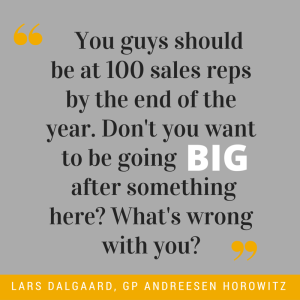
Parker: Yeah. He was like, “You guys should be at 100 sales reps by the end of the year. Don’t you want to be going big, going after something here? What’s wrong with you?”
I was sitting there, and Sam and I looked at each other and I was like, “I don’t know what that was about.”
[laughter]
Parker: But then, it did get us thinking, I started thinking about it. It started off with “What if?” I went to Sam and said, “What if we wanted to hit 20 million in run rate? What do you think that would require?”
Sam was like, “Oh, no way. We’d have to split our sales team in two. We’d have to have someone managing the sales team for smaller companies, and someone for the larger companies.”
I was like, “That’s not so bad, maybe we should do that.” Sam was like, “Yeah. Actually, that’s not a bad idea to get that done a little earlier, anyway.”
It started off as a thought exercise on what it would take to get to something much larger than what we thought we could hit. When we started mapping out what that would look like, it actually seemed doable.
There was a lot of push back from the team because there were people in the company. Matt–who you guys know of–VP of marketing, he was like, “This is f***ing crazy. I can’t believe it. Why would we do this?”
We started, “Treat it like a thought exercise. We’re not going to tell anyone outside the company that’s our goal.” Then like a month later, I started telling like all of our investors that that was our our goal.
[laughter]
Sam: Parker didn’t keep his mouth shut.
Aaron: The self proclaimed prophecy.
Parker: Then it really did become the goal, but by that time people had gotten comfortable enough with it, that it sort of made sense.
Jason: When you changed the goalpost mid season, mid game, like that, if at all, how do you make sure that the team is comfortable with that?
If you’ve doubled the plan, and the sales and marketing team hit 70 percent of the double plan, I don’t think you want people to feel like that they should jump off the roof.
Maybe you did, but how did you negotiate that so that it at least was a win win for everybody? Or, did you not negotiate it?
Parker: I’m not sure if this is the right way to do it, but it started out as like, “It’s not a plan, it’s a hypothetical.” Then it became a plan, but we said, “Listen, if we don’t get to 20, but we beat 10, we’re still going to give ourselves a really big pat on the back and be very happy with this.”
Then it evolved to like, “No, we’d better freaking hit 20.”
Jason: [laughs] .
Parker: It kind of happened slowly. I don’t know.
Sam: We also dedicated a lot of resources differently. At 10 million, our plan was very different in terms of hiring strategy, marketing spend, and all that stuff. Those things increased dramatically to get us to that 20 million.
Parker: We raised another $60 million. 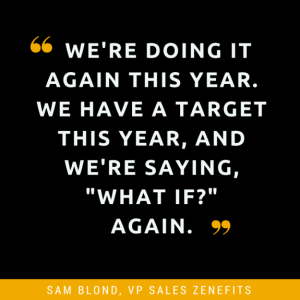
Jason: I know, you took some financial pressure off it, which has helped, not being facetious, but yeah.
Sam: It’s an interesting exercise. We’re doing it again this year. We have a target this year, and we’re saying, “What if?” again. What if we needed to get to 1.3x that target, what would we do differently?
Jason: Yeah. You’re going to redo the plan in February this year? It seems early [laughs] .
Sam: I don’t know. We’ll see. It could be another interesting year for us.
Jason: Let me ask you, Sam, from your perspective. We can’t all do exactly the story that Parker said, but I think, for all of us running SaaS companies, the idea of pushing the plan higher during the year is a great idea.
If you’re failing, you’re failing, but we all, frankly, can do a little better than we’re doing. From your side, how did you stay comfortable? Was that negotiated? Was it just come out of the trust that the two of you have? How do you see it from your chair?
Sam: For us, we created this system by the time we officially made the plan 20 million. We knew what it was going to take, in terms of sales reps, how much business they were going to be able to close, what we were going to need to do in terms of management structure.
There were some things that we did a little bit differently. Phoenix was one of them. We were able to hire much more aggressively in a less expensive market. We made some changes, when you just do the math, you see how you can get there.
We decided collectively that we were going to go for it, with the pretext that had we missed and gotten to 12, 16, 18 million instead of 20…
Jason: You didn’t think you were going to get fired for that.
Sam: Yeah. It was still a great year. We’re still one of the fastest growing SaaS companies ever.
Parker: The other thing that made it possible for us to do this is that, we have a really brilliant VP of Marketing, Matt, who is not here right now. Except for a very brief period of time last year, we were never top of the funnel constrained.
Jason: He would hit his lead commit, whatever it took, right?
Parker: It got to the point where the basic agreement was like, “Listen, Sam, as many sales reps as you can hire.” Matt was going to be able to provide them with demos with companies.
Then it just became a numbers game where it’s like, “Well, if you can’t get there with 30 sales reps, you just need to hire 60 sales reps.” It becomes just about recruiting and training.
Jason: You got comfortable. It’s always an interesting question, do sales reps generate revenue? Obviously, they close deals, but can putting bodies in generate revenue?
In this case, if marketing can clearly deliver their commit, then the answer for Zenefits is, “Yes.”
Sam had carte blanche to hire the number of good people to hit the revenue planned. Sales reps equaled revenue for you, that was the switching point it sounds like, right?
Aaron: Yeah. Sales reps, and also, Matt, the VP of Marketing, he thinks about these levers. One of the levers was, you have 95 sales people, but how many prospectors do you have right now?
Sam: What are we? About 70 SDRs.
Parker: I thought it was like 50, but yeah, somewhere in that range.
Aaron: Remember there is the lead generation, which mostly is done through outbound prospecting. You guys had a funnel, and you had enough data to start to be able to predict if we needed to add. Matt figured out something that worked, and so he felt like he could blow it up.
Sam: When we started 2014, we didn’t have any SDRs. We actually made our first SDR hire at the very beginning of 2014. As the year went on, we realized that that was a lever that we could very easily control, unlike any other inbound lead gen lever, we could pull them.
Today, we know we can hire one SDR that’s going to create x number of leads that will feed x number of reps. We’re able to just push that as hard as we can. It really is a machine today.
It’s all about, how aggressively can we scale without the wheels falling off the track.
Aaron: You guys have a really clean way that you have sales development, marketing and sales work together. Can you share a bit about it, because I think it’s a really good model for people?
Sam: Yeah. We have sales development live in Marketing. It’s a little different. Some people have them live 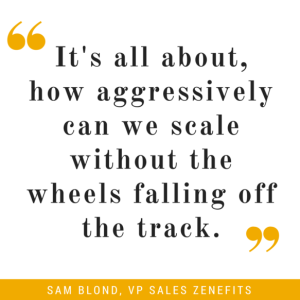 in Marketing, some people have them live in Sales.
in Marketing, some people have them live in Sales.
For us, it made more sense to live in Marketing, because marketing has a lead commit to sales, much like sales has a revenue commit to the rest of the company, so that works out really well for us.
Again, at this point, we know exactly what an SDR is going to produce. This month these numbers are made up, but if we’re going to hire 15 sales reps this month, we know that we need to hire 12 SDRs. If we increase that number from 15, that number from 12 goes to 14, something like that.
Jason: Parker, let’s talk a little bit about capital. You opened the Phoenix office or Scottsdale. I assume, it’s more cost efficient there, but I don’t think that was the number one goal. There is a little bit of capital in the bank. I assume, it’s as much about scaling as efficiency. Is that correct?
Parker: Yeah. It’s just about the number of people that we needed to hire. It got hard to do it in San Francisco.
Jason: That’s my question.
Parker: It was expensive.
Jason: It’s the sheer number of human capital that you need to fuel this engine, right?
Parker: Yeah. I think, we hired about 600 people in 2014. We started out the year at about 50 employees.
Jason: 50 to 600?
Parker: Yeah. 600 and change.
Aaron: That was as of yesterday, but today, 600?
Parker: I think we’re hiring about a hundred a month, right now. There was a limit to how you could do that in San Francisco. Even real estate, it’s hard to get office space. Even if you want spend money on it, if you want to add 30,000 square feet, you can’t do that with 30 days notice. It usually takes six or seven months.
Phoenix was less expensive. It was easier to scale, or it was just another place to scale, at least. Also, the talent there has been great.
It has not been our experience that it’s a step down in these either, and there are a couple of them. There’s Phoenix, there’s Salt Lake City and Denver. The experience has been, a lot of the guys in Phoenix are kicking the butts of the people in San Francisco in a lot of cases on this stuff.
It can be a great way to do it once you’ve got something down and locked and loaded in terms of how you’re going to do it.
Jason: Is it because of the management talent? Because I assume that the individual reps are equivalent. Is it more the management talent that you need to source before you do Phoenix or your version of Phoenix? Because you said, “Here first,” which we’re all doing or many of us are doing.
Parker: It’s hard to do anything at a distance, until it’s really just rinse, wash, repeat.
Once you get to a point where you know you can hire this rep, you can put them through this training program, in x months they’re going to be hitting quota, you have a team of people that you can seed the office with.
We actually sent about 15 or 20 people from San Francisco down to Phoenix to seed that office.
That way, there was a cultural touchstone right from the beginning around, what are the norms about the way things are done in the company? How do you run the demo? How do sales work? Also, with these other teams, how do we do customer support? All that different kind of stuff.
You don’t want to be hiring people from scratch there because then you have no idea where it might veer off into. It can take on a direction that’s very different from what’s working in the home office.
Jason: Let me step back for a minute. It always confuses me when you have a lot of capital, but you still want to have a CAC driven model. You come in. You want to grow faster, you get an extra 60 million bucks in the bank.
Clearly, you want to deploy the capital. Parker, what did you loosen up? I assume, you probably didn’t lower quotas, right?
Parker: What?
Jason: You probably didn’t lower quotas. I don’t think that happened.
Parker: No.
Jason: Just structurally, what did you loosen the belt on with that capital to help you grow faster? Because you still want to have a decent CAC. You wanted to perform, you want to pay for leads that work.
You want the sales reps to hit whatever their quota is, eight hundred thousand, a million. The quota take home isn’t really going to change much. How do you deploy that effectively?
Parker: The way that we did it, there was some basic growth, hiring a lot more engineers.
Jason: Engineers, I got that, but on the revenue side, how do you deploy it?
Parker: The scary reality of the way SaaS works is, almost all of your costs are front loaded. On day one, you kind of drop in a negative territory on a customer. Then, with these subscription businesses, you’re gradually making that money back over time.
With some SaaS, if you do any old contracts, that’s a revenue recognition fiction. For us, because we actually get paid monthly, it’s a real cash issue.
Jason: It doesn’t touch the capital of your cash if you do monthly, yeah.
Parker: What that means is we were looking at it and we were like, “The more successful we are, the more business we close, the more more money we will lose in the short term.”
That’s one of the criticisms that people make about SaaS businesses. It’s like, “The more successful they get, the more money they lose.” It swings down in the short term, and then it comes back up. 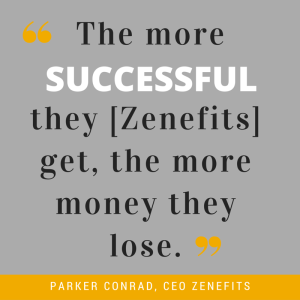
We were looking at it, and I was like, “Geez, there were certain points where our success can actually itself put us out of business.”
Because you close so much business that it puts you into such deep, negative territory that you run out of money. You need a way to bridge that gap to get to when it rebounds from a cash flow perspective.
Jason: There’s an exercise that I like to do some version of, especially, when you’ve hit initial traction at the end of the year is, imagine next year you had no capital constraints to your business at all, what would you do?
Did you go through a version of that exercise? Even after this, did you still feel capital constrained? What did you let the team do where capital didn’t matter? If anything, was there an exercise you did there?
Parker: No. I think it’s dangerous to say what would you do if like money didn’t matter because it does.
Jason: My idea is, the leads still have to perform and the reps still have to close, right?
Parker: Yeah.
Jason: What could you do if we weren’t worrying about money in the business? Maybe it didn’t impact your thinking.
Parker: Yeah, it didn’t. We were very fortunate. This is very different from my last company, but at this company at least we were fortunate that capital hasn’t been the constraint for us.
Other weird constraints and bottlenecks have popped up. There’s always a different one, but it hasn’t been the fundraising side.
Jason: I’ll ask both of you including Sam, trying to literally add the amount of sales headcount that you have over the last 16 months, what were the biggest bottlenecks?
What’s the hardest part? Was it getting an extra layer of management? Was it literally throughput? Because a lot of us have trouble hiring three reps [laughs] .
Sam: Challenges have been different along the way. If we go back to middle of 2014,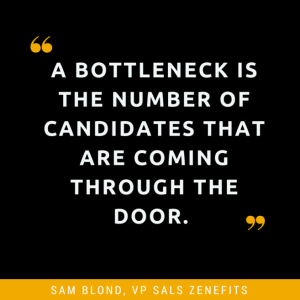 we made a major shift as we alluded to earlier from inbound lead gen coming from marketing activities that were not SDR.
we made a major shift as we alluded to earlier from inbound lead gen coming from marketing activities that were not SDR.
There was a period of time where we had over hired on the sales side, and marketing needed to figure out a way to catch up, so that became a bottleneck for about a month or two. We fixed that very quickly.
Today, a bottleneck is the number of candidates that are coming through the door. We are tripling internal recruiting resources on the sales side to generate more candidates.
We’re also doing things like internal recruiting. HR says we’ve increased the amount that we’re paying people for referring candidates. Bottlenecks change over time, for us we’ve had two or three over the course of the last year.
Aaron: Changes roughly how many resumes you get, to interviews, to hires?
Sam: At this point, recruiting is its own department, whereas, historically recruiting was reporting into the department that they were recruiting for.
I don’t know how many resume submissions there are. I know that we hire about one in four that make it to sales.
Parker: I think on Sam’s side, one of the things that he did really well, in sales more than any other part of the organization, he was very aggressive about promoting people internally early, and I was always very nervous about that.
Sam would say, “We need to promote, Matt Plank and Leah,” and I was like, “What do you mean, isn’t it like… “
Jason: They joined last month [laughs] .
Parker: Top guys…
Jason: Top individual contributors.
Parker: “They’ve only been here three or four months. We’re closing all this business. Let’s not do that, yet,” he was always very aggressive about doing that.
Sales management was never really the bottleneck on the sales side. Management has become a bottleneck at various different points in time for other parts of the company.
In addition to hiring stuff, I think training was a big bottleneck for us on the sales side.
We went from a point where we had no trainers in the company to now having a lot of trainers in the company, and having an entire sales training department of multiple sales trainers in sales with a VP of Sales Enablement to run it.
That shift happened, we went from zero to somewhat fully built out in just a couple months.
Jason: Parker, if it’s changed historically, what do you do in sales? What’s your role? How do you support the team? How much time, if any, do you spend with customers?
Parker: I tend to spend more time with customers post sales than I do on the sales side. I think a lot of that is a function of where our bottlenecks and challenges are which tend to be operationally post close.
I spend a lot of time there, David Sacks, our COO, spends a lot of time there. Because sales and marketing are working really well, I am spending less time there.
I try to get on a demo with one of our enterprise reps once a week or every other week. Sometimes, it ends up being less frequently in practice, but to just hear when people tell us no, why do they tell us no?
It’s really good feedback in this sort of product. It’s hard to get it second hand from the reps because sometimes, what you hear is people want faster horses.
Aaron: Yeah, you got to hear it yourself.
Parker: You got to hear their problems first hand because the solution may be non obvious.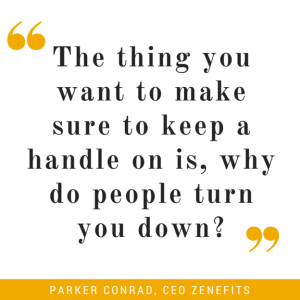
For me, since Sam and his team are doing such a great job, I can spend less time there. The thing you want to make sure to keep a handle on is, why do people turn you down?
Jason: That’s a good insight. How much of your time would you guess, do you spend with the existing customers? Is it budgeted? Do you have a rough sense? Even with David, you’ve got a lot to do, right?
Parker: I’d say I spend probably 90 percent of my time on our ops as a whole. What’s going on with products, integrations, customer support, account management, and renewals? How does that all work?
That’s probably where I spend, but that’s changed over time. Because there was a period of time when marketing had a crisis, then I was spending all my time with Matt on the marketing side for a very brief period of time.
Jason: Let me ask you a question. Zenefits, at some levels, is in a very competitive space, maybe not every single deal is a knuckle brawl. Maybe it is, I don’t know, but at least at a high level, there’s large, entrenched competitors.
With the kind of growth you see, and just the crap you have to get done, how much if any time do you spend worrying about competitors? What’s your advice there to other founders?
Because I think we all worry too much about competition.
Aaron: You must have a lot of copycats now, don’t you?
Parker: Not really, what happens in this hub and spoke model, we have some vicious competition for individual spokes. In every deal, we’re going up against an insurance broker who does the insurance piece, but what we’re selling is this all-in-one integrated system of record.
There are relatively few companies that do that. TriNet’s one, but it’s a very different business model. It’s an expensive product, and they underwrite their clients and end up rejecting a lot of companies because they are poor insurance risks. It’s inherently in each product.
We haven’t seen the same kind of all-in-one approach to this. It’s a hard problem to tackle because most of the time with companies, the conventional wisdom is that you want to focus.
We’re, for better or for worse, taking this opposite approach. The problem is when everyone’s focusing, then the client ends up with 20 different systems for each narrow piece of functionality.
What’s needed is a company like Zenefits to unify them, and bring them all together which means you have to do everything which is hard and a real pain in the ass.
Jason: It’s not high on the list, competition, discussion about competition?
Parker: A lot of our challenges are more internal about the pace at which we’re growing, and how we do that successfully? How do we keep all of our internal chaos from spilling over to our customers? And fix that internal chaos as quickly as possible, so that we can take it to the next level.
Sam: Jason, we’re in a unique situation, because there is no–this might resonate with you–DocuSign or EchoSign. There’s nobody like that that is a truly direct competitor.
For us, as Parker mentioned, we have all of these different spokes, but our biggest revenue driver is commissions on the health insurance dollars, and our competition there is a traditional health insurance broker.
Parker: Yeah, so it’s very diffused.
Sam: What you get with a traditional health insurance broker is no technology. For us, when we show them this incredibly powerful technology platform that comes with us being their broker, that then becomes a no brainer for them. 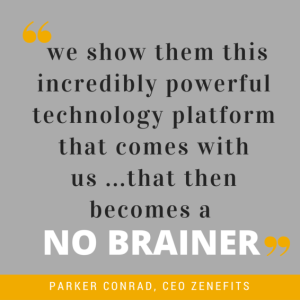
On these sales calls, sort of a sales reps dream, we hear all the time, “Why wouldn’t I do this?” Or, “Why isn’t every company in the United States adopting something like this?” Because, we are giving away the hub for free.
Jason: We’re running out of time. There’s so many things I want to chat about. Help me since I have both of you. Sometimes, CEOs who are doing SaaS for the first time, they magically know exactly how to work with the VP of Sales, but usually it’s a learning experience.
If you have one on ones, what do you guys chat about? You don’t just whip out the Salesforce pipeline do you? How do you work together? How do you manage each other, up and down, or right to left?
Sam: Both are incredibly important. We have a work relationship and a personal relationship. Our work relationship is less formal probably than most. It might surprise you, we don’t have a one on one that’s on our calendar every week.
When we need something done, it’s more spur of the moment. This week, I think, we’ve probably met two or three times a day, and we just get things done. It works well for us. It fits our personality type to take that approach.
On the personal side, we have a great relationship outside of work, and joking within work as well. A couple of stories that come to mind, we did a big sales dinner at Bobo’s one night, and Parker and I were slightly over served, and we ended up on the floor of the restaurant in a wrestling match with each other to end the night.
Half an hour ago, we were up in the green room, we saw two bottles of unopened drinks, and we looked at each other…
Jason: I’m glad it’s been used. That’s good. I was worried that they wouldn’t be unscrewed in the greenroom.
Sam: They’re no longer unopened.
Jason: That’s good. The way you get your transparency is, Parker, Sam, meeting multiple times a day is the answer, right?
Aaron: Are your offices next to each other, or desks?
Parker: No. The only thing that I would say is that I think sometimes conflicts can come up in situations like that when people are in each others shorts, or there’s not a lot of trust.
One of the things that I found about Zenefits is the growth is so overwhelming, and so paralyzing at times that, if I was trying to be really deeply involved in Sam’s part, how you scale sales, I don’t think I could do it.
Jason: Can’t micromanage it.
Parker: You need to have people in each of these areas that you trust well enough that they’re just running with it because there are going to be enough places where you’re going to have to stay involved a lot.
Those are the places where things are going wrong. As much as possible, within the organization you want everything to be running smoothly, so that you can go play video games, or something, and everything is running really well.
To the extent that you have to spend a lot of time deeply involved in any one part of the organization that’s probably a sign that somebody’s not working.
Jason: All right, listen I’d love to go through more. We’re out of time. This was amazing,
Thanks to Parker and Sam, and to Aaron for doing this. This is terrific.
[applause]
[music]
Transcription by CastingWords


